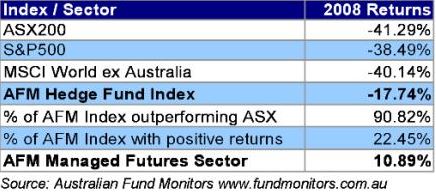
Managed futures are one of the few asset classes that provided investor returns in 2008. We consider the benefits of including this asset class within your portfolio
With the huge turmoil in the markets over the last 18 months or so, most of the clients I have spoken to recently have been questioning whether you can expect to generate any investment returns in this climate. Equities have fallen by about half their value, property has been in turmoil, corporate bonds aren’t favoured since companies’ ability to repay debt is now being called into question and with governments dropping interest rates like its going out of fashion, deposit rates are nothing to write home about either. To top this all off, it looks like we are in a global recession and the next 6-9 months don’t look any better.
Diamonds in the rough?
My experience has shown me that there have always been opportunities for investors, it’s just a question of structuring your portfolio correctly to ensure that you don’t get caught in the herd mentality of buying high and selling low.
2008 has exposed many investors to the pitfalls of not having some exposure to absolute return funds (or hedge funds). The S&P ASX 200 fell by just over 41% in 2008, yet the Australian Fund Monitors (AFM) Hedge Fund Index reports that over 90% of the funds within their index beat the ASX200 in 2008 and just under a quarter of the index managed to produce a positive return. With results like these, this is a sector that is difficult to ignore.
Profiting from a falling market
Absolute return funds have been heralded as the investor’s opportunity to profit from a falling market. Their ability to invest in a wider range of investments allows them to short the market versus traditional managed funds that are limited to going long, only making money in a rising market (‘short’ means you make money if prices fall and ‘long’ positions will make money from higher prices).
Walking the walk

Investment funds promising absolute returns have been around a long time, 2008 has just allowed us to see “Who just talked the talk, and who walked the walk”.
The AFM Hedge Fund Index reported that it lost an average of 17.74% in 2008, and although this is significantly better than the 41.29% that the ASX200 fell, it still begs the question “Where are the returns in both rising and falling markets?”.
The answer in many cases really boils down to the definition of a hedge fund. There are a whole host of managers that are considered hedge fund managers but are really traditional fund managers investing directly in equities and having some small exposure to shorting the market on the way down. ie their aim is not to create absolute returns, rather, provide some type of downside protection in a falling market.
That aside, there are those that simply got it wrong. What 2008 has provided is an insightful stress test to see just who walked the walk, and illustrated the benefits of including some type of exposure to absolute return funds.

Comment: